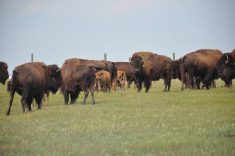NEWDALE, Man. – More Manitobans may soon be raising sheep, eating lamb and spinning wool because of Shelley and Grant Zahaiko.
The couple makes time to talk about their sheep herd or serve up a helping of lamb in their farm kitchen near Newdale, Man.
“Anybody we’ve cooked lamb for has always raved. They can’t believe how good it is,” said Shelley.
When they first entered the sheep business 11 years ago, Shelley did not eat lamb.
Read Also

Trump’s tariffs take their toll on U.S. producers
U.S. farmers say Trump’s tariffs have been devastating for growers in that country.
“I told Grant and my (three) daughters that we’re not going to expect someone else to eat our product if we’re not going to eat it ourselves. It just turned out that we really liked it.”
She grew up in Edmonton and studied animal health technology at Lakeland College in Vermilion, Alta., where she met her first husband. They moved to Shoal Lake, Man., but after the marriage ended, Shelley met Grant, whose family once raised cattle near Newdale.
Grant was specializing in cereals and oilseeds, but the two decided to expand into livestock.
“We wanted to get into some livestock and we found the sheep interesting. They were kind of an up and coming (thing) at the time,” said Grant.
They began with a dozen sheep and now run a herd with 250 animals, including 170 ewes. Most of the sheep in the Zahaiko herd are a Polypay-Texel cross. They also have a few Jacob sheep, a unique looking breed with long horns and spotted coat.
Shelley had never lived on a farm before meeting Grant, but her animal health training eased the transition.
“A couple of weeks ago, we de-wormed. We had to put our hands on every animal in our yard and at the end of the day, my body was tired. But I felt an immediate gratification that we had accomplished something,” she said.
Over the last several years, she has also learned how to use the wool.
“One of my brothers turned 60 and I was thrilled when I gave him a tuque that I had knit. I had spun the wool and it was from our sheep.”
Shelley now owns two spinning wheels and a wool carder and plans to buy a felting machine.
To dispel a common misperception about itchy wool, she brought out a pair of downy soft mitts.
Another misperception is that mutton is tough to eat, but Shelley has prepared many tasty roasts from older animals.
Many Zahaiko lambs wind up on dinner plates in places like Ontario, but Grant said the local market is evolving as more abattoirs and restaurants in Manitoba want to butcher and prepare lamb.
“The restaurants are using it as a drawing card,” he said, explaining that they want something distinct on the menu.
Grant and Shelley, hoping that local demand will continue to grow, plan to begin lambing in spring and fall to satisfy the market.
But they aren’t the only Manitoba producers who plan to tap into the year-round market, Shelley said.
“There are producers recognizing that we have to do this…. But the public will have to be patient with us because it will take us a few years to work into this.”















